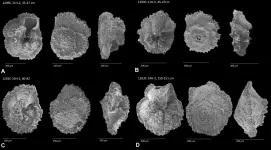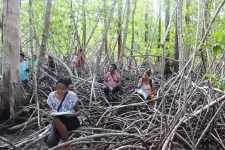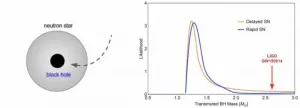(Press-News.org) Astronomers have discovered new hints of a giant, scorching-hot planet orbiting Vega, one of the brightest stars in the night sky.
The research, published this month in The Astrophysical Journal, was led by University of Colorado Boulder student Spencer Hurt, an undergraduate in the Department of Astrophysical and Planetary Sciences.
It focuses on an iconic and relatively young star, Vega, which is part of the constellation Lyra and has a mass twice that of our own sun. This celestial body sits just 25 light-years, or about 150 trillion miles, from Earth--pretty close, astronomically speaking.
Scientists can also see Vega with telescopes even when it's light out, which makes it a prime candidate for research, said study coauthor Samuel Quinn.
"It's bright enough that you can observe it at twilight when other stars are getting washed out by sunlight," said Quinn, an astronomer at the Harvard and Smithsonian Center for Astrophysics (CfA).
Despite the star's fame, researchers have yet to find a single planet in orbit around Vega. That might be about to change: Drawing on a decade of observations from the ground, Hurt, Quinn and their colleagues unearthed a curious signal that could be the star's first-known world.
If the team's findings bear out, the alien planet would orbit so close to Vega that its years would last less than two-and-a-half Earth days. (Mercury, in contrast, takes 88 days to circle the sun). This candidate planet could also rank as the second hottest world known to science--with surface temperatures averaging a searing 5,390 degrees Fahrenheit.
Hurt said the group's research also helps to narrow down where other, exotic worlds might be hiding in Vega's neighborhood.
"This is a massive system, much larger than our own solar system," Hurt said. "There could be other planets throughout that system. It's just a matter of whether we can detect them."
Youthful energy
Quinn would like to try. Scientists have discovered more than 4,000 exoplanets, or planets beyond Earth's solar system, to date. Few of those, however, circle stars that are as bright or as close to Earth as Vega. That means that, if there are planets around the star, scientists could get a really detailed look at them.
"It would be really exciting to find a planet around Vega because it offers possibilities for future characterization in ways that planets around fainter stars wouldn't," Quinn said.
There's just one catch: Vega is what scientists call an A-type star, the name for objects that tend to be bigger, younger and much faster-spinning than our own sun. Vega, for example, rotates around its axis once every 16 hours--much faster than the sun with a rotational period that clocks in at 27 Earth days. Such a lightning-fast pace, Quinn said, can make it difficult for scientists to collect precise data on the star's motion and, by extension, any planets in orbit around it.
To take on that game of celestial hide-and-seek, he and colleagues pored through roughly 10 years of data on Vega collected by the Fred Lawrence Whipple Observatory in Arizona. In particular, the team was looking for a tell-tale signal of an alien planet--a slight jiggle in the star's velocity.
"If you have a planet around a star, it can tug on the star, causing it to wobble back and forth," Quinn said.
Hot and puffy
The search may have paid off, said Hurt, who began the study as a summer research fellow working for Quinn at the CfA. The team discovered a signal that indicates that Vega might host what astronomers call a "hot Neptune" or maybe a "hot Jupiter."
"It would be at least the size of Neptune, potentially as big as Jupiter and would be closer to Vega than Mercury is to the sun," Hurt said.
That close to Vega, he added, the candidate world might puff up like a balloon, and even iron would melt into gas in its atmosphere.
The researchers have a lot more work to do before they can definitively say that they've discovered this sizzling planet. Hurt noted that the easiest way to look for it might be to scan the stellar system directly to look for light emitted from the hot, bright planet.
For now, the student is excited to see his hard work reflected in the constellations: "Whenever I get to go outside and look at the night sky and see Vega, I say 'Hey, I know that star."
INFORMATION:
Other coauthors on the new study include David Latham, Gilbert Esquerdo, Michael Calkins, Perry Berlind, Christian Latham and George Zhou at the CfA; Andrew Vandeburg at the University of Wisconsin-Madison; and Ruth Angus at the American Museum of Natural History.
Microscopic fossilized shells are helping geologists reconstruct Earth's climate during the Paleocene-Eocene Thermal Maximum (PETM), a period of abrupt global warming and ocean acidification that occurred 56 million years ago. Clues from these ancient shells can help scientists better predict future warming and ocean acidification driven by human-caused carbon dioxide emissions.
Led by Northwestern University, the researchers analyzed shells from foraminifera, an ocean-dwelling unicellular organism with an external shell made of calcium carbonate. After analyzing the calcium isotope composition of the fossils, the researchers concluded that massive volcanic activity injected large amounts of carbon dioxide into the Earth system, causing global warming and ocean acidification.
They ...
Artificial intelligence can already scan images of the eye to assess patients for diabetic retinopathy, a leading cause of vision loss, and to find evidence of strokes on brain CT scans. But what does the future hold for this emerging technology? How will it change how doctors diagnose disease, and how will it improve the care patients receive?
A team of doctors led by UVA Health's James H. Harrison Jr., MD, PhD, has given us a glimpse of tomorrow in a new article on the current state and future use of artificial intelligence (AI) in the field of pathology. Harrison and other members of the College of American Pathologists' Machine Learning ...
In a new paper published in Light: Science & Applications, the group led by Professor Andrea Fratalocchi from Primalight Laboratory of the Computer, Electrical and Mathematical Sciences and Engineering (CEMSE) Division, King Abdullah University of Science and Technology (KAUST), Saudi Arabia, introduced a new patented, scalable flat-optics technology manufactured with inexpensive semiconductors.
The KAUST-designed technology leverages on a previously unrecognized aspect of optical nanoresonators, which are demonstrated to possess a physical layer that is completely equivalent to a feed-forward deep neural network.
"What we have achieved," explains Fratalocchi, "is a technological process to cover ...
Women are largely being excluded from decisions about conservation and natural resources, with potentially detrimental effects on conservation efforts globally, according to research.
A University of Queensland and Nature Conservancy study reviewed a swathe of published conservation science, investigating the cause and impact of gender imbalance in the field.
UQ PhD candidate and Nature Conservancy Director of Conservation in Melanesia Robyn James said it was no secret that females were underrepresented in conservation science.
"In fact, according to a recent analysis of 1051 individual top?publishing authors in ecology, evolution and conservation research, only 11 per cent were women," Ms James said.
"We analysed more than 230 peer-reviewed articles attempting ...
One of the world's rarest tree species has been transformed into a sophisticated model that University of Queensland researchers say is the future of plant research.
"Macadamia jansenii is a critically endangered species of macadamia which was only described as a new species in 1991," said Robert Henry, Professor of Innovation at the Queensland Alliance for Agriculture and Food Innovation (QAAFI).
"It grows near Miriam Vale in Queensland and there are only around 100 known trees in existence."
However, with funding from Hort Innovation's Tree Genomics project, and UQ's Genome Innovation Hub Macadamia jansenii has now become the world's most sophisticated plant research model.
Professor Henry said ...
In a perfect world, what you see is what you get. If this were the case, the job of artificial intelligence systems would be refreshingly straightforward.
Take collision avoidance systems in self-driving cars. If visual input to on-board cameras could be trusted entirely, an AI system could directly map that input to an appropriate action -- steer right, steer left, or continue straight -- to avoid hitting a pedestrian that its cameras see in the road.
But what if there's a glitch in the cameras that slightly shifts an image by a few pixels? If the car blindly trusted so-called "adversarial inputs," it might take unnecessary and potentially dangerous action.
A new deep-learning algorithm developed by MIT researchers is designed to help machines ...
Cancers that are resistant to radiotherapy could be rendered susceptible through treatment with immunotherapy, a new study suggests.
Researchers believe that manipulating bowel cancers based on their 'immune landscape' could unlock new ways to treat resistant tumours.
Cancers can evolve resistance to radiotherapy just as they do with drugs.
The new study found that profiling the immune landscape of cancers before therapy could identify patients who are likely to respond to radiotherapy off the bat, and others who might benefit from priming of their tumour with immunotherapy.
Scientists at The Institute of Cancer Research, London, in collaboration with the University of Leeds and The Francis Crick ...
The public doesn't need to know how Artificial Intelligence works to trust it. They just need to know that someone with the necessary skillset is examining AI and has the authority to mete out sanctions if it causes or is likely to cause harm.
Dr Bran Knowles, a senior lecturer in data science at Lancaster University, says: "I'm certain that the public are incapable of determining the trustworthiness of individual AIs... but we don't need them to do this. It's not their responsibility to keep AI honest."
Dr Knowles presents (March 8) a research paper 'The Sanction of Authority: Promoting Public Trust in AI' at the ACM Conference on Fairness, Accountability and Transparency (ACM FAccT).
The ...
Lowering the operating temperature of solar panels by just a few degrees can dramatically increase the electricity they generate over their lifetime, KAUST researchers have shown. The hotter a panel gets, the lower its solar power conversion efficiency (PCE) and the faster it will degrade and fail. Finding ways to keep solar panels cool could significantly improve the return on investment of solar-power systems.
The long-standing focus of photovoltaics (PV) research has been to improve solar modules' PCE and make solar power more cost-competitive than nonrenewable power ...
What is the origin of black holes and how is that question connected with another mystery, the nature of dark matter? Dark matter comprises the majority of matter in the Universe, but its nature remains unknown.
Multiple gravitational wave detections of merging black holes have been identified within the last few years by the Laser Interferometer Gravitational-Wave Observatory (LIGO), commemorated with the 2017 physics Nobel Prize to Kip Thorne, Barry Barish, and Rainer Weiss. A definitive confirmation of the existence of black holes was celebrated with the 2020 physics Nobel Prize awarded to Andrea Ghez, Reinhard Genzel and ...




